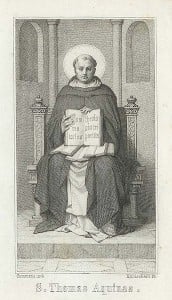 We’re blogging through St. Thomas Aquinas’ Compendium Theologiae, sometimes called his Shorter Summa. Find the previous posts here.
We’re blogging through St. Thomas Aquinas’ Compendium Theologiae, sometimes called his Shorter Summa. Find the previous posts here.
Today’s post is from Chapter 59, “Why These Properties Are Called Notions”.
NOTE: This post should have appeared a couple of weeks ago. I wrote it, and then forgot to post it. My apologies; it was a difficult week, as my mother-in-law had just passed away. Here is the post, (alas) out of sequence.
In the past two chapters, Thomas has been describing the properties that distinguish the Divine Persons from each other; and in doing so, he’s done some violence to the usual meaning of the word property in scholastic philosophy. Consequently, he takes this chapter to relate his meanings to the more usual definition. Before we jump in we need to define the usual meanings of several terms, or we won’t follow him.
Scholastic metaphysics, following Aristotle, is largely about things that are and the kinds of things you can say about them: or, to use more technical terminology, substances and the things you can predicate of them. Consider my golden retriever. First of all, he’s a dog; that’s his essence. Second, he is an air-breather. That follows from his being a dog, and you can’t change it without
getting rid of the dog altogether. We call this a property, something proper to being a dog. Properties of being a dog include having fur, shedding, have two eyes, a sensitive nose, four legs, and a tale. Any given dog might lack some of these due to injury or deformation; but precisely because of that, we would say that such a dog isn’t a proper dog. On the other hand, whether my golden retriever is awake or asleep isn’t a property; it changes regularly over the course of the day.
A property is an attribute of a single substance. When you speak of what is true of two substances together, you have what Aristotle calls a relation. Now, consider the Trinity. Here we have three persons, distinguished by their relations, who are nevertheless one in substance. Can you see how the standard terminology begins to break down? Thomas, always tidy, has to deal with this.
These five properties can be called notions of the persons, for the reason that the distinction between the persons in God is brought to our notice through them.
When I use the word notion I mean a vague, not entirely formed idea. Thomas says that a notion is something that brings something else to our notice: as when he uses the word spiration, it brings to mind the relation between the Father and Son on one hand and the Spirit on the other. (Or, at least, it does if you’ve read the last few chapters attentively.) Thus, even for Thomas a notion is something rather more vague than a property.
On the other hand, they cannot be called properties, if the root meaning of a property is insisted on, so that a property is taken to mean a characteristic pertaining to one individual alone; for common spiration pertains to the Father and the Son.
Spiration is not a property in the narrow sense of the word, being a kind of relation, but, he says, it’s a property in a looser sense, as when you divide all kinds of animal into the two-footed and the four-footed.
But if the word “property” is employed in the sense of an attribute that is proper to some individuals as setting them off from others, in the way that “two-footed,” for example, is proper to man and bird in contradistinction to quadrupeds, there is nothing to prevent even common spiration from being called a property.
However, spiration also has the nature of a relation since the Holy Spirit proceeds from both the Father and the Son.
Since, however, the persons in God are distinguished solely by relations, and distinction among the divine persons is manifested by the notions, the notions must in some sense pertain to relationship. But only four of the notions are real relations, whereby the divine persons are related to one another.
One of the five “properties” or “notions” that distinguish the Divine Persons is not like the others: the Father is distinguished by not proceeding, which is an absence of relation. But when we speak of a lack of anything, we speak in terms of the thing that is lacking. If I say of someone’s that he’s no gentleman, I’m appealing to the common notion of gentleman. So even here we’re speaking of relation.
The fifth notion, innascibility, pertains to relation as being the denial of relation; for negations are reduced to the genus of affirmations, and privations are reduced to the genus of habits, as, for example, not man is reduced to the genus of man, and not white is reduced to the genus of whiteness.
Finally, some of the notions are proper relationships in our terms, such as paternity and filiation, which describe my father’s relationship with me and mine with him. For others, such as spiration, we have no human analog; and so we name the relationship after the origin of the relationship, lacking anything better
We should note that among the relations whereby the divine persons are related to one another, some have definite names, such as paternity and filiation, which properly signify relationship. But others lack a definite name: those whereby the Father and the Son are related to the Holy Spirit, and the Holy Spirit is related to them. So for these we use names of origin in place of relative names. We perceive clearly that common spiration and procession signify origin, but not relations that follow origin. This can be brought out in the case of the relations between the Father and the Son. Generation denotes active origin, and is followed by the relation of paternity; and nativity signifies the passive generation of the Son, and is followed by the relation of filiation. In like manner, some relation follows common spiration, and the same is true of procession. But as these relations lack definite names, we use the names of the actions instead of relative names.







